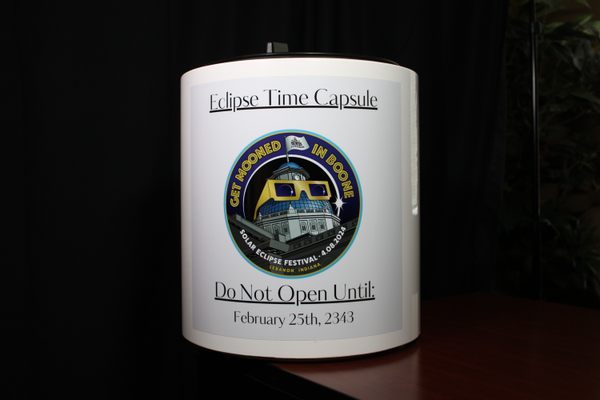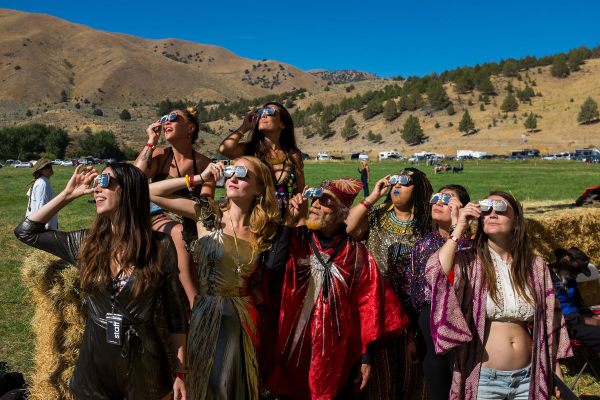On Seeing the Eclipse With a Crowd
What I learned while camping out with hundreds of people in the middle of the Oregon desert.
The night before the August 21 solar eclipse in Durkee, Oregon, the sky was clear, and so were the roads.
For days, all over the country, millions of people had been moving toward this one line of ground, stretching from Oregon, through Idaho and Wyoming, Nebraska and Kansas, Missouri, Kentucky, Tennessee, all the way to South Carolina. Masses of human beings maneuvered themselves into place so that, on the same day, within the same short window of time, they could see the moon pass in front of the sun. In the dry mountains of Eastern Oregon, the squat tanks of the National Guard patrolled, but the night was calm.
People traveled to Durkee, where Atlas Obscura hosted its Total Eclipse festival, because it was a “once in a lifetime event.” Many people said the same thing to me this weekend. They wanted to experience it for themselves. Some had been waiting to see a total eclipse since childhood, when they first started wondering about the cosmos. Some had memories of partial eclipses from their younger days. “When I was in fifth grade, I remember seeing it, through a little pinhole, looking through the fifth grade window,” says Christine Eister. She requested to take off of work this week a year and a half ago, to make sure she could experience being “in awe like I was in fifth grade” again.
“It’s rare to see something so spectacular that you don’t see every day or every year, and that is not created by people,” Jess Beebe told me. Beebe had traveled from Northern California, and had been planning to see this eclipse since the time she witnessed an annular eclipse that ended with everyone saying “see you in 2017.” At this farm in Eastern Oregon, many said they’d wanted to experience the eclipse with others, to feel a connection with fellow human beings. “There is joy… or awe… or optimism in the idea that all over the country everyone is turning their eyes up and looking at the sun to see this happen,” says Beebe. “I feel some hope in that.”
There aren’t many times in our lives when we might feel awe, but a total solar eclipse is “pristine,” in the words of Margaret Longstreth, who had seen one total eclipse prior to this year’s, in Venezuela.
This day began like any other day: the sun came up, the cold of the night dispersed, and it was hot. Usually, the light of the sun blinds us to the endless everything that’s out there beyond our own tiny ball of spinning rock. This morning, the moon blocked out that bright light.
The eclipse began here with a curve of moon moving onto the top right edge of the sun. Awe can make time seem to slow down, but it seemed like the moon was moving fast. Look away for a minute or two, and more of the sun disappeared, until it slimmed to a last sliver, a thin, crescent ember, and the air seemed thicker, like it would take effort to move. Then, in a moment, the world through the eclipse glasses went dark. The black moon hung in front of the sun. The mountains surrounded us, and above them hung a ring of dusky light, just as a ring of steaming sunlight hung around the moon.
When the totality began, a cheer went up, then quieted. Above the murmur, there were a few drifting exclamations. A kid, in a child’s high voice, said it simplest and clearest: “This is so awesome.” That kid was seeing something he’d never seen before, and that was true of most of us there. We had never seen anything like this. Some had waited decades to see it.
It seemed impossible that anyone in the path of totality would not stop to look at the energy of the sun bursting out from behind the moon, to see the sky turn a purple, uncanny dark. But in every total eclipse there are stories of people driving through, turning on their lights, unmoved by what might be happening above. Not everyone who finds themselves in the path of a total solar eclipse sees it. The people who see the eclipse are the people who choose to look.








Follow us on Twitter to get the latest on the world's hidden wonders.
Like us on Facebook to get the latest on the world's hidden wonders.
Follow us on Twitter Like us on Facebook